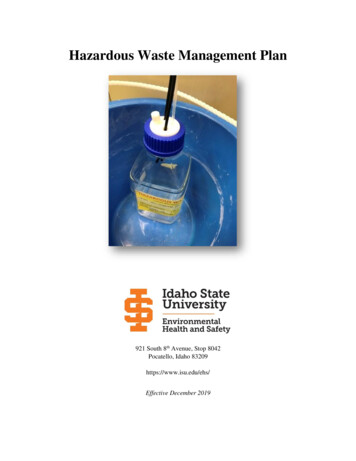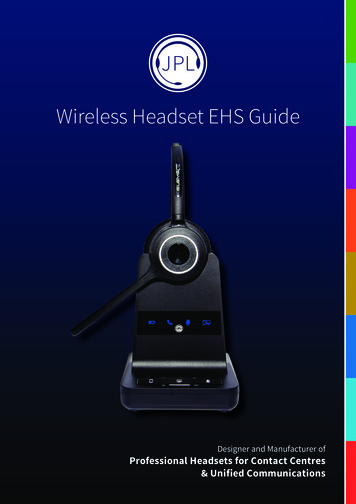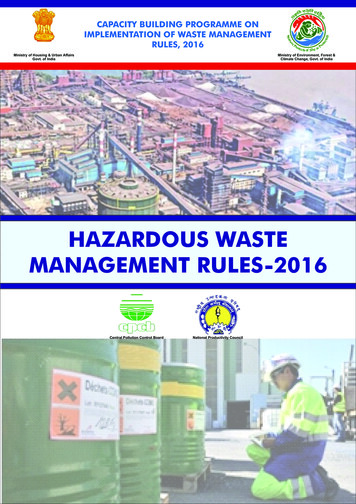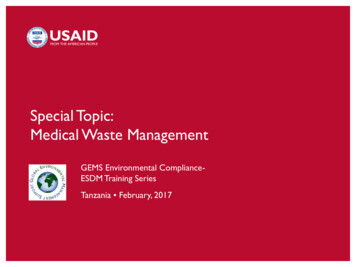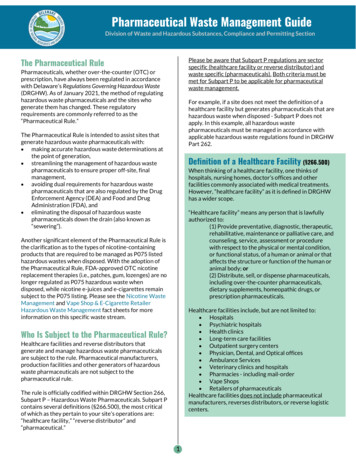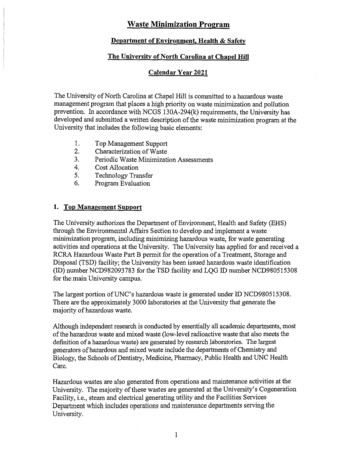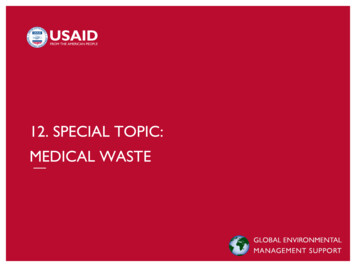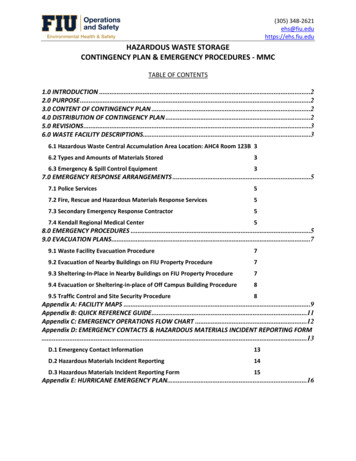
Transcription
(305) 348-2621ehs@fiu.eduhttps://ehs.fiu.eduHAZARDOUS WASTE STORAGECONTINGENCY PLAN & EMERGENCY PROCEDURES - MMCTABLE OF CONTENTS1.0 INTRODUCTION .22.0 PURPOSE .23.0 CONTENT OF CONTINGENCY PLAN .24.0 DISTRIBUTION OF CONTINGENCY PLAN .25.0 REVISIONS .36.0 WASTE FACILITY DESCRIPTIONS.36.1 Hazardous Waste Central Accumulation Area Location: AHC4 Room 123B 36.2 Types and Amounts of Materials Stored36.3 Emergency & Spill Control Equipment37.0 EMERGENCY RESPONSE ARRANGEMENTS .57.1 Police Services57.2 Fire, Rescue and Hazardous Materials Response Services57.3 Secondary Emergency Response Contractor57.4 Kendall Regional Medical Center58.0 EMERGENCY PROCEDURES .59.0 EVACUATION PLANS .79.1 Waste Facility Evacuation Procedure79.2 Evacuation of Nearby Buildings on FIU Property Procedure79.3 Sheltering-In-Place in Nearby Buildings on FIU Property Procedure79.4 Evacuation or Sheltering-in-place of Off Campus Building Procedure89.5 Traffic Control and Site Security Procedure8Appendix A: FACILITY MAPS .9Appendix B: QUICK REFERENCE GUIDE .11Appendix C: EMERGENCY OPERATIONS FLOW CHART .12Appendix D: EMERGENCY CONTACTS & HAZARDOUS MATERIALS INCIDENT REPORTING FORM.13D.1 Emergency Contact Information13D.2 Hazardous Materials Incident Reporting14D.3 Hazardous Materials Incident Reporting Form15Appendix E: HURRICANE EMERGENCY PLAN.16
(305) 348-2621ehs@fiu.eduhttps://ehs.fiu.edu1.0 INTRODUCTIONThis contingency plan has been prepared by Florida International University Environmental Health &Safety (EH&S), which is responsible for hazardous waste management, facility operations, spill control,and emergencies. The Florida International University Modesto Maidique Campus is classified as a LargeQuantity Generator of hazardous waste with the DEP/EPA ID Number FLD980839518.2.0 PURPOSEThe contingency plan is designed to minimize the health and environment effects from fires, explosions,or any unplanned sudden or non-sudden release of hazardous waste or hazardous waste constituents toair, soil, or surface water. The plan will be implemented in case of a fire, explosion, or release of hazardouswaste or hazardous waste constituents that could threaten human health or the environment.3.0 CONTENT OF CONTINGENCY PLANThe contingency plan describes the actions facility personnel will take in an emergency situation. The planalso describes arrangements agreed to by University Police, Miami Dade County Fire/Rescue, Miami DadeEmergency Response, and Kendall Regional Medical Center. Contractors and state emergency planningcommittees will be contacted as needed to coordinate emergency services.Included in the plan are lists of the following: The names and phone numbers (office, home, cell) of all persons qualified to act as emergencycoordinators. This list shall be kept up-to-date.The emergency equipment that is available at the Modesto Maidique Campus.4.0 DISTRIBUTION OF CONTINGENCY PLANCopies of the contingency plan will be kept at the following locations: Environmental Health and Safety Office – Academic Health Center 4 (AHC4) Room 121Environmental Health and Safety Office – Campus Support Complex (CSC) Room 146University Police, Modesto A. Maidique CampusAdditionally, the contingency plan will be provided to the following organizations. Florida Department of Environmental Protection (DEP)3301 Gun Club RoadWest Palm Beach, FL 33406 Miami Dade Fire Rescue/Emergency Response9300 NW 41st StreetMiami, FL 33178 Kendall Regional Medical Center11750 SW 40th StreetMiami, FL 33175 South Florida Local Emergency Planning Committee1 Oakwood Blvd, Suite 250Hollywood, FL 33020Revised: 07/8/2021EHS-DOC200.02 – MMC Contingency PlanPage 2 of 17
(305) 348-2621ehs@fiu.eduhttps://ehs.fiu.edu5.0 REVISIONSThe contingency plan will be reviewed and/or revised annually or when any of the following situationsoccur: Applicable regulations are revised.The plan fails in an emergency.The facility changes in its design, construction, operation, maintenance or other circumstances.The list of emergency coordinators has changed.The list of emergency equipment has changed.Upon revision of the contingency plan, it will be redistributed as specified above.6.0 WASTE FACILITY DESCRIPTIONSFIU has a single central hazardous waste storage location for the Modesto Maidique Campus. The wastestorage room is equipped with sprinkler protection, fire alarm and smoke detection system, a HM-200model fire extinguishing package, and explosion rated walls. These systems are monitored by the FIUPolice Department. In the event of an alarm, a signal is sent to FIU Public Safety who then calls the localfire department, FIU Police Department and FIU Environmental Health and Safety. The hazardous wastestorage staging area (AHC4-123) has a 10-pound ABC fire extinguisher and the hazardous waste storageroom (AHC4-123B) is equipped with a FM 200 clean agent fire suppression system.6.1 Hazardous Waste Central Accumulation Area Location: AHC4 Room 123BThe AHC4 hazardous waste central accumulation area is located on the first floor of the building in room123B. The building entrance is located at door 120W3 in the vehicle loading dock, shown in Appendix A.The building can also be entered via door 120W1 from the sidewalk on the opposite side, also shown inAppendix A. Access into the waste room AHC4-123B is accessible by way of room AHC4-123, referred toas the staging room. This staging room houses all emergency and spill control equipment listed below.The AHC4 building is located along the northeastern boundary of the campus. Hazardous waste centralaccumulation room 123B is approximately 156 square feet.6.2 Types and Amounts of Materials StoredThe following ranges of hazardous chemicals and materials are routinely stored in the wastes storagerooms at any given time. A computerized database and waste logbooks containing detailed listings ofwastes in the rooms are kept at the EH&S offices at both BBC and MMC.BuildingAHC4Waste TypeAcutely rs6.3 Emergency & Spill Control EquipmentThe following emergency and spill control equipment is available in the AHC4 Room 123 staging room. Avariety of other emergency response equipment is available at the EH&S Office in CSC 146 should it beneeded.Revised: 07/8/2021EHS-DOC200.02 – MMC Contingency PlanPage 3 of 17
(305) ical DescriptionCapabilitiesAHC4 123Tyvek chemical resistance coverallsProtect body from minor chemical hazardsAHC4 123Safety gogglesProtect eyes from chemical splashesAHC4 123Nitrile/neoprene glovesProtect hands from chemical exposuresAHC4 123Clay absorbent (i.e.Oil-Dry, Kitty Litter)Absorbent for organic solvents, oil spillsAHC4 123Spill control for acid and base spillsAHC4 123AHC4 123Acid/base absorbent socks, pillows, andmatsOil/coolant/solvent/water socks, pillows,and mats32” rubber hip boots and plastic bootiesVermiculiteAHC4 123Bio-Fluids absorbentAbsorb biohazardous spillsAHC4 123Acid neutralizer and spill kitNeutralizes acid spillsAHC4 123Caustic neutralizerNeutralizes base spillsAHC4 123Formaldehyde spill kit (includes looseabsorbent and wipers)Mercury clean-up kit (includes absorbentpowder and wipers)Solvent adsorbentRadioactive-wash or equivalentBrooms, brushes, scoops, spatulas, & dustpansDrums, buckets, jugs, totesPolyethylene bagsImpermeable red biomedical waste bagsDuct tapeABC Fire extinguishersEyewash & safety showerBuilding fire alarm systemFirst aid kitCleans up small spills of formaldehydeAHC4 123AHC4 123AHC4 123AHC4 123AHC4 123AHC4 123AHC4 123AHC4 123AHC4 123AHC4 123AHC4 123AHC4 123AHC4 123Revised: 07/8/2021EHS-DOC200.02 – MMC Contingency PlanSpill control for oil, coolant, and solvent spillsOffers foot and leg protection from chemical spillsdrum packing material, chemical absorptionClean up small mercury spillsCleans up solvent spillsradioactive decontamination of smooth surfacesClean up spilled solids.Containerize wastes for disposalCollect and dispose wasteDispose biomedical wasteSeal spill waste in bagFight small firesIrrigate eyes/drench body upon chemical exposureNotify building occupants to evacuate buildingProvides medical assistance for small woundsPage 4 of 17
(305) 348-2621ehs@fiu.eduhttps://ehs.fiu.edu7.0 EMERGENCY RESPONSE ARRANGEMENTS7.1 Police ServicesFIU has its own state-certified law enforcement agency, which acts as first responders to any emergencyon the Modesto Maidique Campus. The FIU Police Department has entered into a county-wide MutualAid Agreement with all other Miami-Dade County law enforcement agencies. Assistance from any ofthese agencies may be requested as provided for in the agreement. In the event of a major emergency,the FIU Police will determine the extent of additional resources required and request assistance fromthe appropriate agency or agencies.7.2 Fire, Rescue and Hazardous Materials Response ServicesFire, rescue, and hazardous material response are provided primarily by Miami-Dade Fire/Rescue. Toursof the Research, teaching and campus support facilities, including the waste storage room (AHC4-123) isoffered annually to the Miami-Dade County Fire Rescue Departments and the FIU Campus Police. Whenexplosives, dried picric acid, organic peroxides, shock-sensitive chemicals and chemical mixtures areinvolved in an emergency, the FIU Police will request assistance from the Miami-Dade Fire Rescue HazmatUnit, which is equipped with equipment for the removal and disposal of such materials.7.3 Secondary Emergency Response ContractorFIU will utilize the services of SWS Environmental Services in accordance with the provisions containedin the Florida Department of Environmental Protection (FDEP) contract. SWS Environmental Servicesprovides emergency response to hazardous materials incidents and has access to the personnel andequipment necessary to respond to a large-scale release of hazardous materials at FIU. The Miami DadeCounty Fire/Rescue Hazmat Team will be the primary responder and will stabilize the incident. Shouldthe need for a large scale clean up arise, the University will execute an expedited purchase order withSWS Environmental Services.7.4 Kendall Regional Medical CenterImmediate treatment of injured personnel is available at the Kendall Regional Medical Center’s 24-hourEmergency Center. The hospital is located approximately 5 miles South of the University’s ModestoMaidique Campus. The hospital has been familiarized with the properties of the hazardous wasteshandled at our facility and the types of injuries that could result from fires, explosions, or releases of thesematerials at our facility.8.0 EMERGENCY PROCEDURESIn the event of an imminent or actual emergency situation, the emergency coordinator (or their designeewhen the emergency coordinator is not available) must immediately: Activate internal facility alarms or communication systems, where applicable, to notify all facilitypersonnel; and Notify appropriate State or local agencies with designated response roles if their help is needed,and Follow the Emergency Operations Flow Chart (Appendix C).When there is a release, fire, or explosion, the emergency coordinator must immediately identify thecharacter, exact source, amount, and a real extent of any released materials. They may do this byRevised: 07/8/2021EHS-DOC200.02 – MMC Contingency PlanPage 5 of 17
(305) 348-2621ehs@fiu.eduhttps://ehs.fiu.eduobservation or review of facility records or manifests and, if necessary, by chemical analysis.Concurrently, the emergency coordinator must assess possible hazards to human health or theenvironment that may result from the release, fire, or explosion. This assessment must consider bothdirect and indirect effects of the release, fire, or explosion (e.g., the effects of any toxic, irritating, orasphyxiating gases that are generated, or the effects of any hazardous surface water run-offs from wateror chemical agents used to control fire and heat-induced explosions).If the emergency coordinator determines that the facility has had a release, fire, or explosion which couldthreaten human health, or the environment outside the facility, findings must be reported as follows: If the assessment indicates that evacuation of local areas may be advisable, they mustimmediately notify appropriate local authorities. They must be available to help appropriateofficials decide whether local areas should be evacuated (see Evacuation Plans); andThe emergency coordinator must immediately notify the National Response Center at 800-4248802 and local authorities if the release of hazardous waste threatens human health or theenvironment outside the facility. The report must include all information on the “HazardousMaterials Incident Reporting Form” in Appendix D. The emergency coordinator must implement the contingency plan and submit a written report tothe Florida Department of Environmental Protection within 15 days if the release of hazardouswaste threatens human health or the environment inside the facility. The report must include allinformation on the “Hazardous Materials Incident Reporting Form” in Appendix D. If hazardous waste stored in a tank is released in any amount above 1 pound, a phone call to theEPA must be made within 24 hours and a written report must be submitted to the EPA within 30days.During an emergency, the emergency coordinator must take all reasonable measures necessary to ensurethat fires, explosions, and releases do not occur, recur, or spread to other hazardous wastes at the facility.These measures must include, where applicable, stopping processes and operations, collecting andcontaining released waste, and removing or isolating containers.If the facility stops operations in response to a fire, explosion or release, the emergency coordinator mustmonitor for leaks, pressure buildup, gas generation, or ruptures in valves, pipes, or other equipment,where it is appropriate.Immediately after an emergency, the emergency coordinator must provide for treatment, storage, ordisposal of recovered waste, contaminated soil or surface water, or any other material that results froma release, fire, or explosion at the facility.The emergency coordinator must ensure that, in the affected area(s) of the facility: No waste that may be incompatible with the released material is treated, stored, or disposed ofuntil cleanup procedures are completed; and All emergency equipment listed in the contingency plan is cleaned and fit for its intended useRevised: 07/8/2021EHS-DOC200.02 – MMC Contingency PlanPage 6 of 17
(305) 348-2621ehs@fiu.eduhttps://ehs.fiu.edubefore operations are resumed.The owner or operator must notify the Florida Department of Environmental Protection and appropriatestate and local authorities that cleanup procedures have been completed before operations are resumedin the affected area(s) of the facility.9.0 EVACUATION PLANSIn the event of a fire, explosion, or release of hazardous wastes from a waste storage facility, thefollowing procedures are to be followed.The Emergency Coordinator and University Police shall determine whether any nearby buildings on FIUproperty need to be evacuated, or whether the occupants of those buildings should be sheltered-inplace. The Emergency Coordinator and University Police will notify the occupants of those buildings ofthe need to evacuate or shelter-in-place.The Emergency Coordinator, through University Police, shall advise emergency responders from theappropriate jurisdictions as to whether any buildings or areas off campus should be evacuated orsheltered-in-place.9.1 Waste Facility Evacuation Procedure Activate the waste facility fire alarm system and/or notify waste facility occupants to exit thebuilding by voice. The primary evacuation route shall be through the nearest non-affected doorway leading to theexterior of the building. The alternate evacuation route shall be through any other available doorway leading to theexterior of the building. Once outside the building, evacuees shall move away from the building in a safe direction (i.e.upwind from the hazard). Call 911 from a safe location using landline or cell phone.9.2 Evacuation of Nearby Buildings on FIU Property Procedure The Emergency Coordinator and university police officers shall verbally instruct buildingoccupants to leave or activate the fire alarm system. The primary evacuation route shall be through the nearest non-affected doorway leading to theexterior of the building. The alternate evacuation route shall be through any other available doorway leading to theexterior of the building. Once outside the building, evacuees shall move away from the building in a safe direction (i.e.upwind from the hazard).9.3 Sheltering-In-Place in Nearby Buildings on FIU Property Procedure The Emergency Coordinator and university police officers verbally instruct building occupants ofthe need to shelter-in-place. This will be done in person or by telephone. Police officers or other volunteers will be placed at exit ways to instruct people to stay in thebuilding. The building will be sealed to the extent practical and necessary and air handling equipment willRevised: 07/8/2021EHS-DOC200.02 – MMC Contingency PlanPage 7 of 17
(305) 348-2621ehs@fiu.eduhttps://ehs.fiu.edube turned off or switched to 100% recirculation, if possible and as appropriate.Occupants will be notified verbally, in person or by telephone when it is safe to go outside.9.4 Evacuation or Sheltering-in-place of Off Campus Building Procedure The Emergency Coordinator will be available to the appropriate emergency responders to helpdecide whether off campus facilities may need to be evacuated or sheltered-in-place. The appropriate emergency responders will be responsible for instructing affected individuals toevacuate or shelter-in-place.9.5 Traffic Control and Site Security Procedure Traffic control and security of the affected areas on the FIU Modesto Maidique Campus will beestablished by the FIU PD with assistance from the Emergency Coordinator and localjurisdictions. Traffic control and security of any affected areas off campus will be established by theappropriate local jurisdiction with assistance from the Emergency Coordinator and the FIU PD.Revised: 07/8/2021EHS-DOC200.02 – MMC Contingency PlanPage 8 of 17
(305) 348-2621ehs@fiu.eduhttps://ehs.fiu.eduAPPENDIX A: FACILITY MAPSFigure A.1: Entry route to central accumulation area building AHC4 from SW 8th StreetRevised: 07/8/2021EHS-DOC200.02 – MMC Contingency PlanPage 9 of 17
(305) 348-2621ehs@fiu.eduhttps://ehs.fiu.eduFigure A.2: Multiple points of entry and floorplan of AHC4 1st floor. The entrance marked with an Xrefers to the primary entry point outlined in Figure A.1 (120W3). The unmarked entrance represents analternate point of entry from a side door (120W1).Revised: 07/8/2021EHS-DOC200.02 – MMC Contingency PlanPage 10 of 17
(305) 348-2621ehs@fiu.eduhttps://ehs.fiu.eduAPPENDIX B: QUICK REFERENCE GUIDEThis quick reference guide is designed to provide rapid, easy access to important information andguidance during an emergency. Types, names, and maximum amounts of hazardous wastes stored onsite and associated hazards:toxic, flammable, corrosive, and reactive wastes are produced. Mercury, acrolein, sodium azide,dibromobenzene, benzaldehyde, benzene, and hydrofluoric acid exposure may require specialattention.Street map of facility in relation to nearby community (central accumulation area marked in yellow):The entrance marked with an X has the fire department connection outside of it Onsite notification systems: FIU Alter Emergency Notification System,Emergency CoordinatorsPrimaryTamece Knowles305-348-7882 (office)786-942-5833 (cell)Revised: 07/8/2021EHS-DOC200.02 – MMC Contingency PlanAlternate #1Gina Oubrar305-348-6849 (office)305-904-5128 (cell)Alternate #2Enrique Badia305-348-7835 (office)786-271-1856 (cell)Page 11 of 17
(305) 348-2621ehs@fiu.eduhttps://ehs.fiu.eduAPPENDIX C: EMERGENCY OPERATIONS FLOW CHARTFire/Explosion/Releaseof Hazardous WasteFIU EH&S or PD evaluate situationbased on available informationMajorAccidentMinorAccidentCall university police: 7-5911Requesting immediate outsidehelp: Fire Dept/Haz Mat TeamEvacuate buildingand vicinityAlert occupants andothers in the vicinity ofimmediate dangerHazard notadequatelycontrolledHazard undercontrolAid victims: extricatedecontaminate stabilizeconditionsInform fire fighters andhazmat staff type ofaccident and chemicalcontents of buildingNotify medical staff of the chemicalexposures received by the victimsClean up site and assessdamageReplace emergencyresponse equipmentDocument the incidentReview and revisecontingency planRevised: 07/8/2021EHS-DOC200.02 – MMC Contingency PlanPage 12 of 17
(305) 348-2621ehs@fiu.eduhttps://ehs.fiu.eduAPPENDIX D: EMERGENCY CONTACTS & HAZARDOUS MATERIALS INCIDENTREPORTING FORMD.1 Emergency Contact InformationNAMETamece KnowlesEMERGENCY COORDINATORSTITLEOFFICEPRIMARY305-348Director, EH&S7882HOMECELL786-9425833Alternates (in order)Gina OubrarEnrique BadiaAssistant Director, EH&SAssistant Director, b title and job description for each position related to hazardous waste managementTamece Knowles: Director of EH&S As the Director of EH&S at all of FIU’s campuses, Tamece is responsible for overall EH&Scompliance with federal, state, local, and university requirements including: R&D laboratory/chemical safety, biological safety, controlled substances, environmental compliance, fire safety,general operations safety, nanomaterial, radiation, and safety training.Gina Oubrar: Assistant Director of EH&S As the Assistant Director of Lab Safety for all campuses at FIU, Gina provides support and guidancefor the EH&S lab safety units in the areas of general lab safety, hazardous waste management,biosafety, chemical safety, radiation safety, controlled substances, laser safety, andnanomaterials. She also oversees research proposal safety reviews, indoor air qualityassessments, safety and compliance inspections, and lab facility evaluations.Enrique Badia: Assistant Director of EH&S As the Assistant Director of General/Industrial Safety for all campuses at FIU, Enrique managesindoor air quality, high risk programs, petroleum storage tanks (above ground tanks andunderground tanks), regulatory compliance with OSHA, DERM, EPA, and DEP, environmentalpermits/issues (except asbestos), and the stormwater program.Emergency Telephone Numbers Fire or Hazardous Materials IncidentState Warning PointNational Response CenterMiami-Dade County Emergency ManagementKendall Regional Medical Center Emergency RoomMiami-Dade Police DepartmentRevised: 07/8/2021EHS-DOC200.02 – MMC Contingency Plan7-5911 (dialing from campus landline)(800) 320-0519(800) 424-8802(305) 468-5400(350) 223-3000.(305) 476-5423Page 13 of 17
(305) 348-2621ehs@fiu.eduhttps://ehs.fiu.edu Miami-Dade Fire Department(786) 331-5000Additional Telephone Numbers for Serious Chemical Releases DEP Southeast DistrictDEP Tallahassee (Cleanup Section)DEP Bureau of Solid/Hazardous WasteDEP Tallahassee (Emergency Response)DEP (24 hour/after business hours)CHEMTREC (Chemical Information)EPA Emergency Planning & Community Right-To-Know(561) 681-6600(850) 245-2118(850) 245-8705(850) 245-2010(800) 320-0519(800) 262-8200(404) 562-9150D.2 Hazardous Materials Incident ReportingIf a hazardous materials incident (i.e., release, fire, explosion, etc.) could threaten human health or theenvironment outside the facility (i.e., off FIU property), the Emergency Coordinator must:1) Determine if evacuation of local areas may be advisable, notify appropriate local authorities, andbe available to help local authorities decide if evacuations are warranted.2) Notify the State Warning Point, if necessary, at 800-320-0519 or the National Response Center at800-424-8802 using the form in section D.3.Revised: 07/8/2021EHS-DOC200.02 – MMC Contingency PlanPage 14 of 17
(305) 348-2621ehs@fiu.eduhttps://ehs.fiu.eduD.3 Hazardous Materials Incident Reporting FormFLORIDA INTERNATIONAL UNIVERSITYEnvironmental Health and Safety11200 SW 8th streetMiami, FL 33199USEPA Identification Number: FLD980839518Person Calling: Caller’s Phone #Building Name:Location:INCIDENT INFORMATION:Date:Time:Type of Incident (fire, explosion, chemical release, etc.):Name and quantity of hazardous material involved (to the extent known):Extent of injuries (if any):Assessment of possible hazards to human health or environment outside the facility:Estimated quantity and disposition of recovered materials:Revised: 07/8/2021EHS-DOC200.02 – MMC Contingency PlanPage 15 of 17
(305) 348-2621ehs@fiu.eduhttps://ehs.fiu.eduAPPENDIX E: HURRICANE EMERGENCY PLANResearch Facility and Research Expansion Waste Storage RoomsRevised: 02/18PURPOSEThe purpose of this attachment is to establish procedures to be implemented prior to, during, andfollowing a hurricane. This plan will be inserted in the Modesto Maidique Campus Hazardous WasteContingency Plan and copies will be kept in the Environmental Health and Safety Offices (BBC &MMC).TERMSIn the event a hurricane threatens the South Florida area, the National Weather Service will issuewarning information through public releases for press, radio and television. Two of the terms used inhurricane advisories are:Hurricane Watch - This condition is declared when it appears that the storm poses a threat to a specificarea. The watch usually covers an area of several hundred miles. It implies the possibility ofdangerous conditions within 24-48 hours.Hurricane Warning - This condition is declared when it appears probable that the storm will hit aspecific area. The hurricane conditions are considered to be imminent or at least within 12-24 hours.PRE-HURRICANE The Primary Emergency Coordinator is to ensure the requirements of this plan are carried out. Inthe absence of the Primary Emergency Coordinator, an alternate will be designated. Typically,this will be an EH&S trained staff member who is familiar with the chemical inventory in AHC4123. The Primary Emergency Coordinator will ensure all EH&S personnel are aware of this plan andknow their responsibilities in the event of an emergency. Any equipment or materials needed to carry out this plan are to be ordered ahead of time andstored in the EH&S Office located in CSC-146.HURRICANE WATCH, The Primary Emergency Coordinator will request applicable EH&S personnel review this plan andprioritize their work schedule accordingly. Any items outside the AHC4 Building that could become airborne in high winds will be broughtinto the building or secured in place. Waste pick-ups will be suspended until conditions return to normal. A copy of the current hazardous waste inventories for AHC4 will be bagged and kept in AHC4123B and the EH&S Office (CSC 146).HURRICANE WARNING Be sure all water-reactive, potentially unstable and extremely hazardous chemicals are labeledand bagged in watertight plastic bags or watertight containers. This procedure should also befollowed for radioactive materials.Revised: 07/8/2021EHS-DOC200.02 – MMC Contingency PlanPage 16 of 17
(305) 348-2621ehs@fiu.eduhttps://ehs.fiu.edu All drums containing bulk chemicals should be labeled with waterproof markings in numerousplaces as to their identity and contents. All drum lid openings must be tightly sealed and secured.All safety equipment (labels, pillows, meters, respirators, absorbent, or other items) subject towater damage should be labeled and placed in the higher areas of the building.The University Police should be notified that the waste storage areas have been evacuated andsecured.Points of Contact:Tamece Knowles, Director, EH&SLocation: CSC 163Office: (305) 348-7882Cell: (786) 942-5833E-mail: knowles@fiu.eduGina Oubrar, Assistant Director, EH&SLocation: AHC4 121Office: (305) 348-6849Cell: (305) 904 - 5128E-mail: gigallia@fiu.eduEnrique Badia, Assistant Director, EH&SLocation: CSC 165Office: (305) 348-7835Cell: (786) 271-1856E-mail: ebadiaso@fiu.eduRevised: 07/8/2021EHS-DOC200.02 – MMC Contingency PlanPage 17 of 17
Quantity Generator of hazardous waste with the DEP/EPA ID Number FLD980839518. 2.0 PURPOSE The contingency plan is designed to minimize the health and environment effects from fires, explosions, or any unplanned sudden or non-sudden release of hazardous waste or hazardous waste constituents to air, soil, or surface water.

